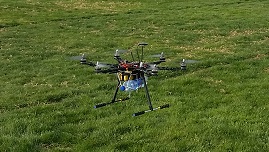Shaping the future: Our strategy for research and innovation in humanitarian response.

Shaping the future: Our strategy for research and innovation in humanitarian response.


At the end of 2017 our early stage innovation phase grant came to an end. With funding from Elrha’s Humanitarian Innovation Fund and support from Virginia Diodes Inc. and the Geneva International Center for Humanitarian Demining, we were able to develop a millimeter wave radar system capable of capturing images of metal targets buried up to 25cm in sand.

Our system achieved record performance for a ground penetrating radar and demonstrated a proof of concept for an imaging system for enhanced UXO identification. The previous state of the art in ground penetrating millimeter wave radar had demonstrated imaging of buried mines up to only 5cm. Using a microwave holographic imaging algorithm, we were able to construct 3D images of the buried targets. The figure on the left shows a 3D image of 2 targets at different ranges.
A summary of our findings has been submitted for publication in the IEEE (Institute of Electronic and Electrical Engineering) Transactions on Microwave Theory and Techniques Journal. The IEEE is the world’s largest technical professional organisation and an accepted publication will receive wide viewership.

In addition, we developed a HEX copter drone and demonstrated hovering with a payload of 1kg which is significantly greater than the weight of the radar (0.25kg). The figure on the right shows a 1litre bottle of water mounted to our newly developed drone.
These achievements have been major milestones in the road toward our goal. In spite of these successes, there are still several steps ahead before such a platform can be diffused for implementation in the field:
Currently, our lab at the University of California Davis is continuing research on collision avoidance for the HEX copter and enabling the autonomous flight control for the drone. We are also continuing imaging studies for enhanced discrimination between natural object such as large rocks and man-made metal objects such as mines or UXOs. New data will continue to be published and we will keep moving forward towards our goal of developing an Autonomous UXO Identification Platform.

 Please upgrade your browser
Please upgrade your browser
You are seeing this because you are using a browser that is not supported. The Elrha website is built using modern technology and standards. We recommend upgrading your browser with one of the following to properly view our website:
Windows MacPlease note that this is not an exhaustive list of browsers. We also do not intend to recommend a particular manufacturer's browser over another's; only to suggest upgrading to a browser version that is compliant with current standards to give you the best and most secure browsing experience.